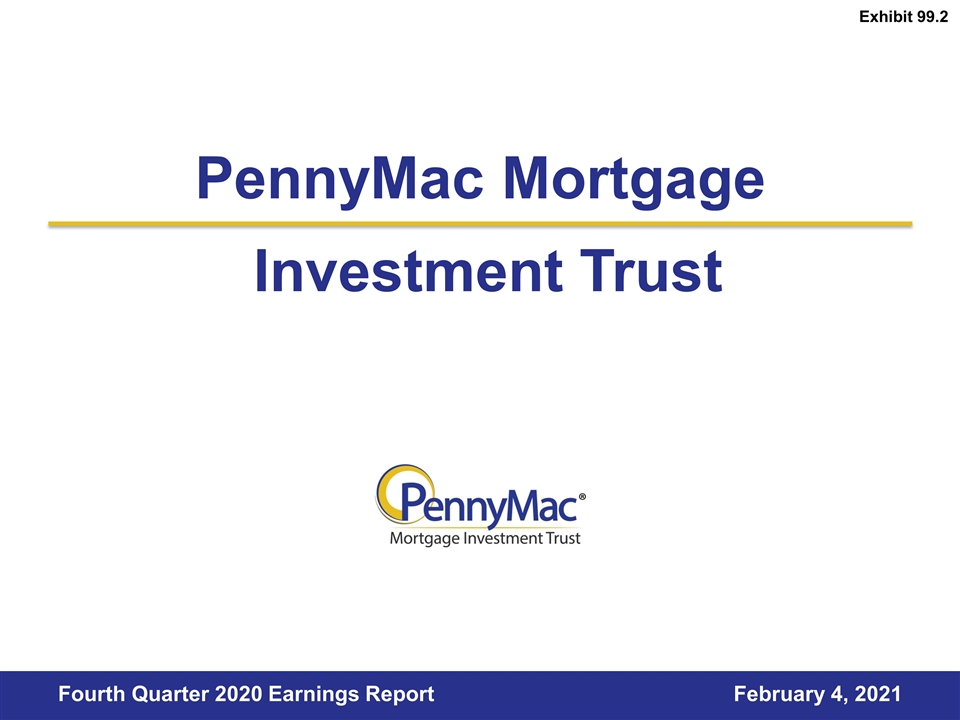
PennyMac Mortgage Investment Trust February 4, 2021 Fourth Quarter 2020 Earnings Report Exhibit 99.2
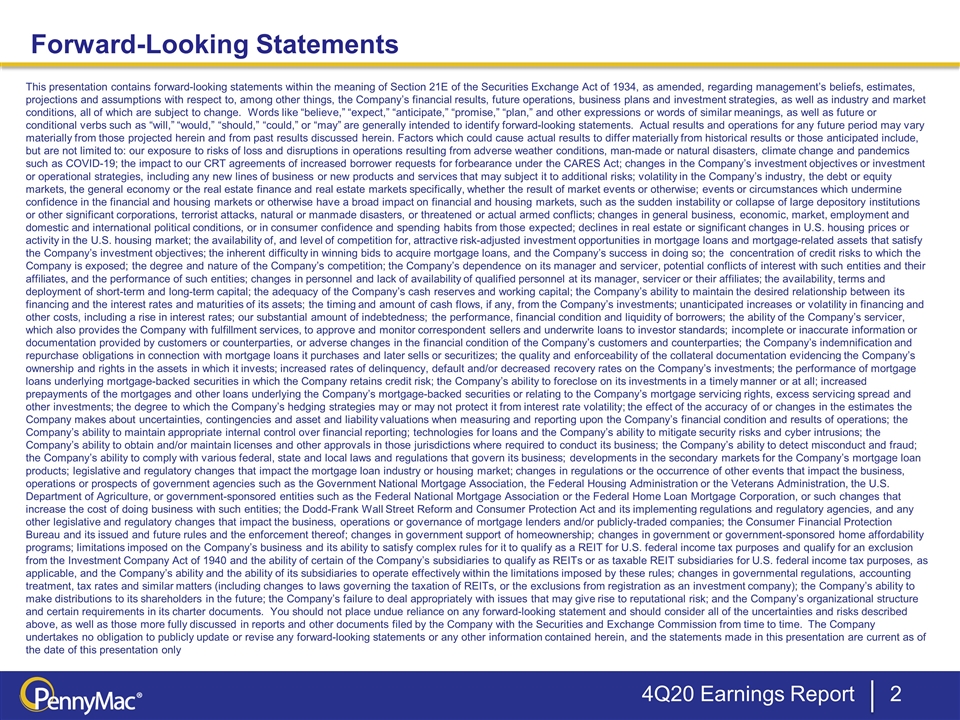
This presentation contains forward-looking statements within the meaning of Section 21E of the Securities Exchange Act of 1934, as amended, regarding management’s beliefs, estimates, projections and assumptions with respect to, among other things, the Company’s financial results, future operations, business plans and investment strategies, as well as industry and market conditions, all of which are subject to change. Words like “believe,” “expect,” “anticipate,” “promise,” “plan,” and other expressions or words of similar meanings, as well as future or conditional verbs such as “will,” “would,” “should,” “could,” or “may” are generally intended to identify forward-looking statements. Actual results and operations for any future period may vary materially from those projected herein and from past results discussed herein. Factors which could cause actual results to differ materially from historical results or those anticipated include, but are not limited to: our exposure to risks of loss and disruptions in operations resulting from adverse weather conditions, man-made or natural disasters, climate change and pandemics such as COVID-19; the impact to our CRT agreements of increased borrower requests for forbearance under the CARES Act; changes in the Company’s investment objectives or investment or operational strategies, including any new lines of business or new products and services that may subject it to additional risks; volatility in the Company’s industry, the debt or equity markets, the general economy or the real estate finance and real estate markets specifically, whether the result of market events or otherwise; events or circumstances which undermine confidence in the financial and housing markets or otherwise have a broad impact on financial and housing markets, such as the sudden instability or collapse of large depository institutions or other significant corporations, terrorist attacks, natural or manmade disasters, or threatened or actual armed conflicts; changes in general business, economic, market, employment and domestic and international political conditions, or in consumer confidence and spending habits from those expected; declines in real estate or significant changes in U.S. housing prices or activity in the U.S. housing market; the availability of, and level of competition for, attractive risk-adjusted investment opportunities in mortgage loans and mortgage-related assets that satisfy the Company’s investment objectives; the inherent difficulty in winning bids to acquire mortgage loans, and the Company’s success in doing so; the concentration of credit risks to which the Company is exposed; the degree and nature of the Company’s competition; the Company’s dependence on its manager and servicer, potential conflicts of interest with such entities and their affiliates, and the performance of such entities; changes in personnel and lack of availability of qualified personnel at its manager, servicer or their affiliates; the availability, terms and deployment of short-term and long-term capital; the adequacy of the Company’s cash reserves and working capital; the Company’s ability to maintain the desired relationship between its financing and the interest rates and maturities of its assets; the timing and amount of cash flows, if any, from the Company’s investments; unanticipated increases or volatility in financing and other costs, including a rise in interest rates; our substantial amount of indebtedness; the performance, financial condition and liquidity of borrowers; the ability of the Company’s servicer, which also provides the Company with fulfillment services, to approve and monitor correspondent sellers and underwrite loans to investor standards; incomplete or inaccurate information or documentation provided by customers or counterparties, or adverse changes in the financial condition of the Company’s customers and counterparties; the Company’s indemnification and repurchase obligations in connection with mortgage loans it purchases and later sells or securitizes; the quality and enforceability of the collateral documentation evidencing the Company’s ownership and rights in the assets in which it invests; increased rates of delinquency, default and/or decreased recovery rates on the Company’s investments; the performance of mortgage loans underlying mortgage-backed securities in which the Company retains credit risk; the Company’s ability to foreclose on its investments in a timely manner or at all; increased prepayments of the mortgages and other loans underlying the Company’s mortgage-backed securities or relating to the Company’s mortgage servicing rights, excess servicing spread and other investments; the degree to which the Company’s hedging strategies may or may not protect it from interest rate volatility; the effect of the accuracy of or changes in the estimates the Company makes about uncertainties, contingencies and asset and liability valuations when measuring and reporting upon the Company’s financial condition and results of operations; the Company’s ability to maintain appropriate internal control over financial reporting; technologies for loans and the Company’s ability to mitigate security risks and cyber intrusions; the Company’s ability to obtain and/or maintain licenses and other approvals in those jurisdictions where required to conduct its business; the Company’s ability to detect misconduct and fraud; the Company’s ability to comply with various federal, state and local laws and regulations that govern its business; developments in the secondary markets for the Company’s mortgage loan products; legislative and regulatory changes that impact the mortgage loan industry or housing market; changes in regulations or the occurrence of other events that impact the business, operations or prospects of government agencies such as the Government National Mortgage Association, the Federal Housing Administration or the Veterans Administration, the U.S. Department of Agriculture, or government-sponsored entities such as the Federal National Mortgage Association or the Federal Home Loan Mortgage Corporation, or such changes that increase the cost of doing business with such entities; the Dodd-Frank Wall Street Reform and Consumer Protection Act and its implementing regulations and regulatory agencies, and any other legislative and regulatory changes that impact the business, operations or governance of mortgage lenders and/or publicly-traded companies; the Consumer Financial Protection Bureau and its issued and future rules and the enforcement thereof; changes in government support of homeownership; changes in government or government-sponsored home affordability programs; limitations imposed on the Company’s business and its ability to satisfy complex rules for it to qualify as a REIT for U.S. federal income tax purposes and qualify for an exclusion from the Investment Company Act of 1940 and the ability of certain of the Company’s subsidiaries to qualify as REITs or as taxable REIT subsidiaries for U.S. federal income tax purposes, as applicable, and the Company’s ability and the ability of its subsidiaries to operate effectively within the limitations imposed by these rules; changes in governmental regulations, accounting treatment, tax rates and similar matters (including changes to laws governing the taxation of REITs, or the exclusions from registration as an investment company); the Company’s ability to make distributions to its shareholders in the future; the Company’s failure to deal appropriately with issues that may give rise to reputational risk; and the Company’s organizational structure and certain requirements in its charter documents. You should not place undue reliance on any forward-looking statement and should consider all of the uncertainties and risks described above, as well as those more fully discussed in reports and other documents filed by the Company with the Securities and Exchange Commission from time to time. The Company undertakes no obligation to publicly update or revise any forward-looking statements or any other information contained herein, and the statements made in this presentation are current as of the date of this presentation only Forward-Looking Statements 4Q20 Earnings Report

4Q20 Earnings Report Fourth Quarter Highlights Net income attributable to common shareholders of $76.6 million; diluted earnings per common share of $0.78 Continued recovery in the fair value of government-sponsored enterprise (GSE) credit risk transfer (CRT) investments due to credit spread tightening combined with strong Correspondent Production segment results Segment pretax results: Credit Sensitive Strategies: $134.5 million; Interest Rate Sensitive Strategies: $(100.1) million; Correspondent Production: $52.7 million; Corporate: $(13.3) million Dividend of $0.47 per common share, returning to pre-COVID levels, declared on December 18, 2020 and paid on January 29, 2021 Book value per common share increased to $20.30 from $19.95 at September 30, 2020 Investment activity driven by elevated correspondent production volumes Record conventional correspondent loan production volumes of $38.0 billion in unpaid principal balance (UPB), up 39% from the prior quarter and up 85% from 4Q19 Added $441 million in new MSRs Settled PMT’s sixth CRT transaction with Fannie Mae and successfully placed $500 million of 2-year term-notes shortly after closing Repurchased approximately 927,000 common shares of PMT at a weighted average price of $16.88, or a total cost of $15.6 million

4Q20 Earnings Report PMT Is Focused on Unique Investment Strategies in Three Segments Correspondent Production Credit Sensitive Strategies Interest Rate Sensitive Strategies Leading producer of conventional conforming mortgage loans PMT entered the correspondent production business in 2011 after large banks, which had historically dominated the channel, reduced their participation Significant opportunity in the current environment Investments in credit risk on PMT’s high-quality loan production In 2015, PMT began organically investing in innovative front-end GSE CRT investments and ceased new investments in 4Q20 Approximately $59 billion in UPB of loans underlying PMT’s CRT investments at December 31, 2020 MSR investments created through the securitization of conventional correspondent loan production Hedged with Agency MBS and other interest rate hedges Strong track record and discipline in hedging interest rate risk
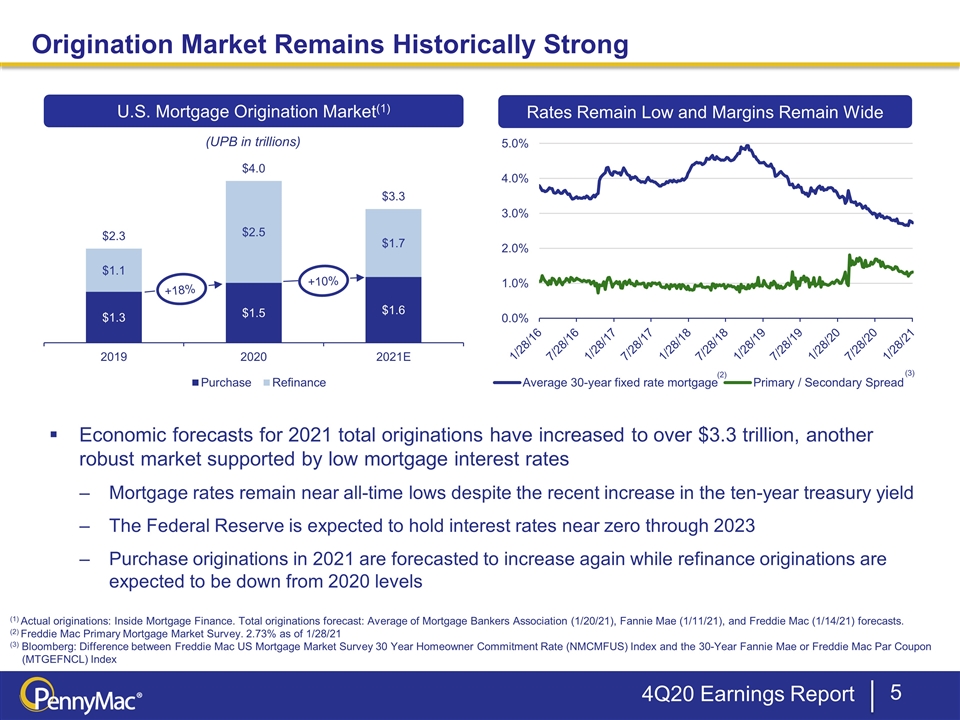
4Q20 Earnings Report Origination Market Remains Historically Strong (1) Actual originations: Inside Mortgage Finance. Total originations forecast: Average of Mortgage Bankers Association (1/20/21), Fannie Mae (1/11/21), and Freddie Mac (1/14/21) forecasts. (2) Freddie Mac Primary Mortgage Market Survey. 2.73% as of 1/28/21 (3) Bloomberg: Difference between Freddie Mac US Mortgage Market Survey 30 Year Homeowner Commitment Rate (NMCMFUS) Index and the 30-Year Fannie Mae or Freddie Mac Par Coupon (MTGEFNCL) Index U.S. Mortgage Origination Market(1) (UPB in trillions) Rates Remain Low and Margins Remain Wide Economic forecasts for 2021 total originations have increased to over $3.3 trillion, another robust market supported by low mortgage interest rates Mortgage rates remain near all-time lows despite the recent increase in the ten-year treasury yield The Federal Reserve is expected to hold interest rates near zero through 2023 Purchase originations in 2021 are forecasted to increase again while refinance originations are expected to be down from 2020 levels +18% +10% (2) (3)
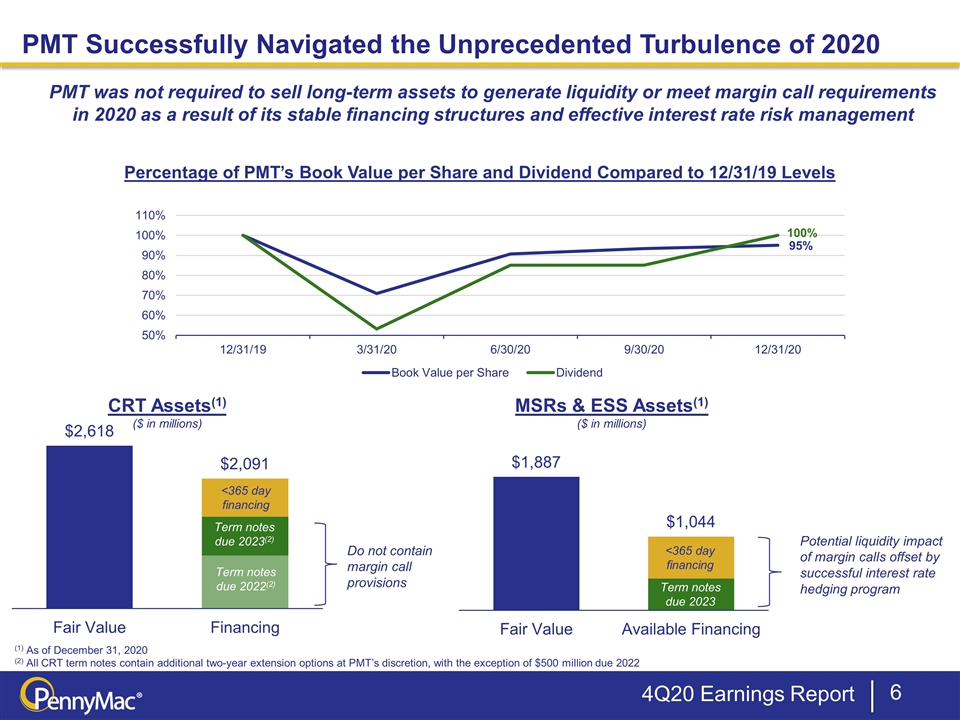
4Q20 Earnings Report PMT Successfully Navigated the Unprecedented Turbulence of 2020 CRT Assets(1) ($ in millions) MSRs & ESS Assets(1) ($ in millions) (1) As of December 31, 2020 (2) All CRT term notes contain additional two-year extension options at PMT’s discretion, with the exception of $500 million due 2022 Term notes due 2022(2) Term notes due 2023(2) <365 day financing Term notes due 2023 <365 day financing Do not contain margin call provisions Potential liquidity impact of margin calls offset by successful interest rate hedging program PMT was not required to sell long-term assets to generate liquidity or meet margin call requirements in 2020 as a result of its stable financing structures and effective interest rate risk management Percentage of PMT’s Book Value per Share and Dividend Compared to 12/31/19 Levels
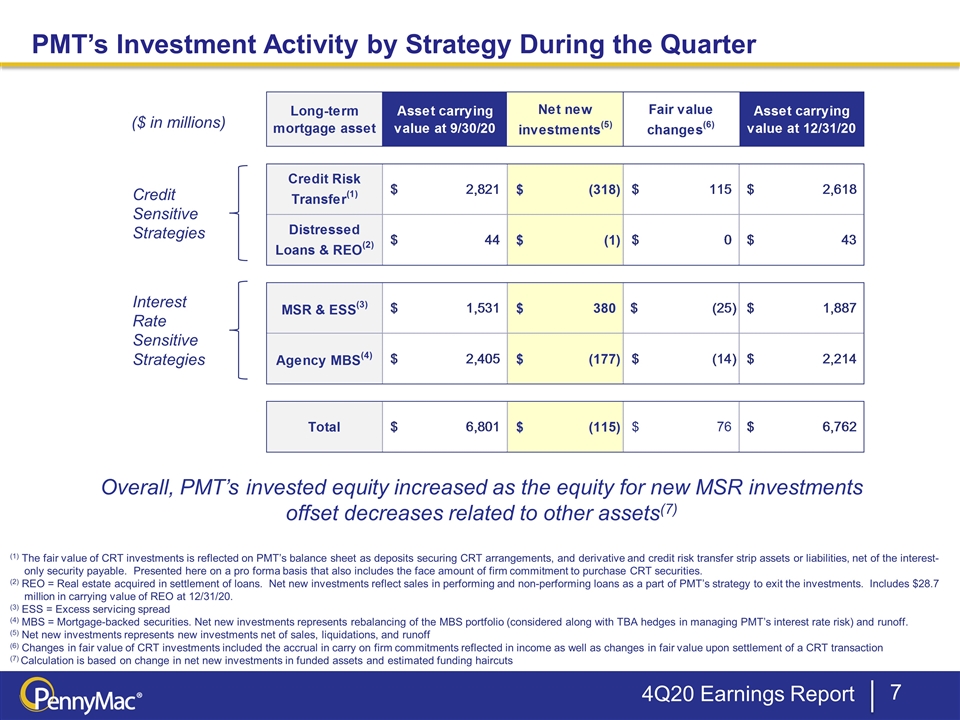
4Q20 Earnings Report PMT’s Investment Activity by Strategy During the Quarter Credit Sensitive Strategies Interest Rate Sensitive Strategies ($ in millions) (1) The fair value of CRT investments is reflected on PMT’s balance sheet as deposits securing CRT arrangements, and derivative and credit risk transfer strip assets or liabilities, net of the interest-only security payable. Presented here on a pro forma basis that also includes the face amount of firm commitment to purchase CRT securities. (2) REO = Real estate acquired in settlement of loans. Net new investments reflect sales in performing and non-performing loans as a part of PMT’s strategy to exit the investments. Includes $28.7 million in carrying value of REO at 12/31/20. (3) ESS = Excess servicing spread (4) MBS = Mortgage-backed securities. Net new investments represents rebalancing of the MBS portfolio (considered along with TBA hedges in managing PMT’s interest rate risk) and runoff. (5) Net new investments represents new investments net of sales, liquidations, and runoff (6) Changes in fair value of CRT investments included the accrual in carry on firm commitments reflected in income as well as changes in fair value upon settlement of a CRT transaction (7) Calculation is based on change in net new investments in funded assets and estimated funding haircuts Overall, PMT’s invested equity increased as the equity for new MSR investments offset decreases related to other assets(7)
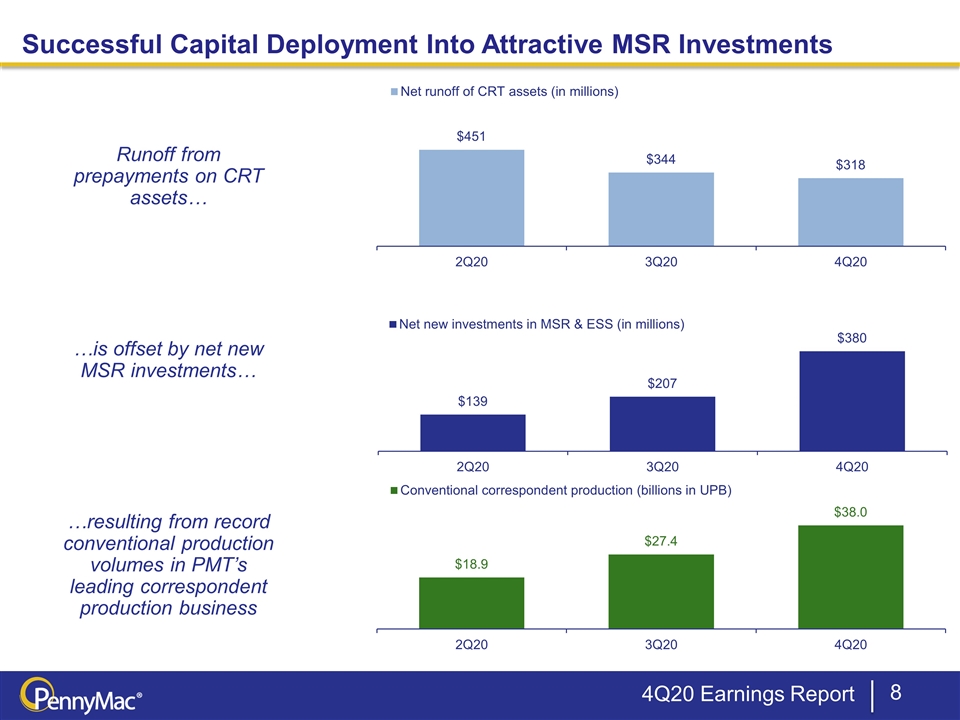
4Q20 Earnings Report Successful Capital Deployment Into Attractive MSR Investments Runoff from prepayments on CRT assets… …is offset by net new MSR investments… …resulting from record conventional production volumes in PMT’s leading correspondent production business
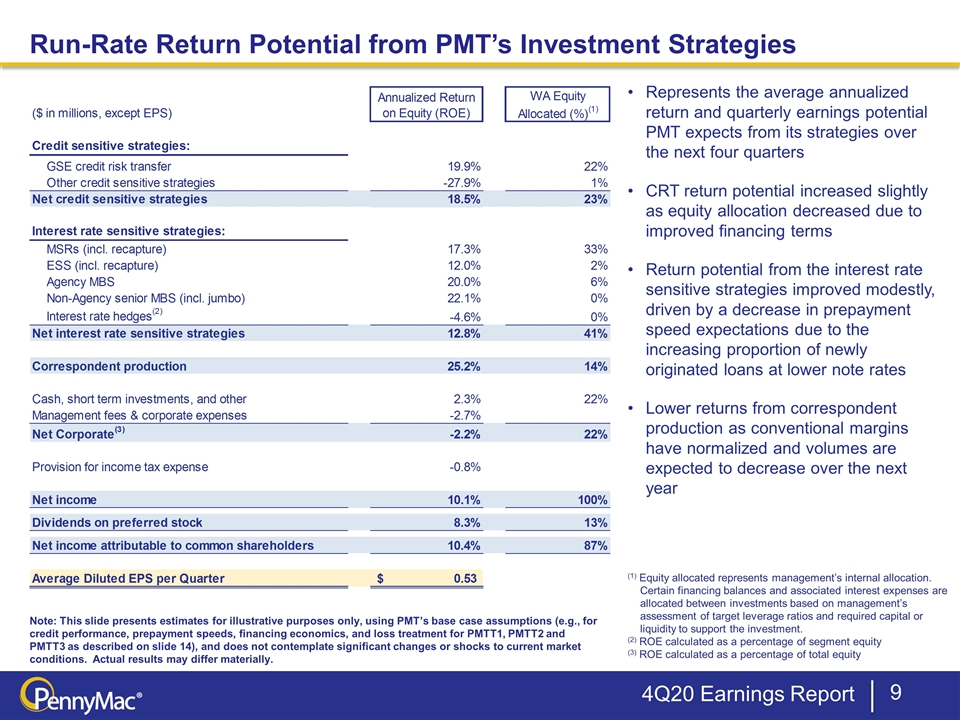
4Q20 Earnings Report Run-Rate Return Potential from PMT’s Investment Strategies Note: This slide presents estimates for illustrative purposes only, using PMT’s base case assumptions (e.g., for credit performance, prepayment speeds, financing economics, and loss treatment for PMTT1, PMTT2 and PMTT3 as described on slide 14), and does not contemplate significant changes or shocks to current market conditions. Actual results may differ materially. (1) Equity allocated represents management’s internal allocation. Certain financing balances and associated interest expenses are allocated between investments based on management’s assessment of target leverage ratios and required capital or liquidity to support the investment. (2) ROE calculated as a percentage of segment equity (3) ROE calculated as a percentage of total equity Represents the average annualized return and quarterly earnings potential PMT expects from its strategies over the next four quarters CRT return potential increased slightly as equity allocation decreased due to improved financing terms Return potential from the interest rate sensitive strategies improved modestly, driven by a decrease in prepayment speed expectations due to the increasing proportion of newly originated loans at lower note rates Lower returns from correspondent production as conventional margins have normalized and volumes are expected to decrease over the next year
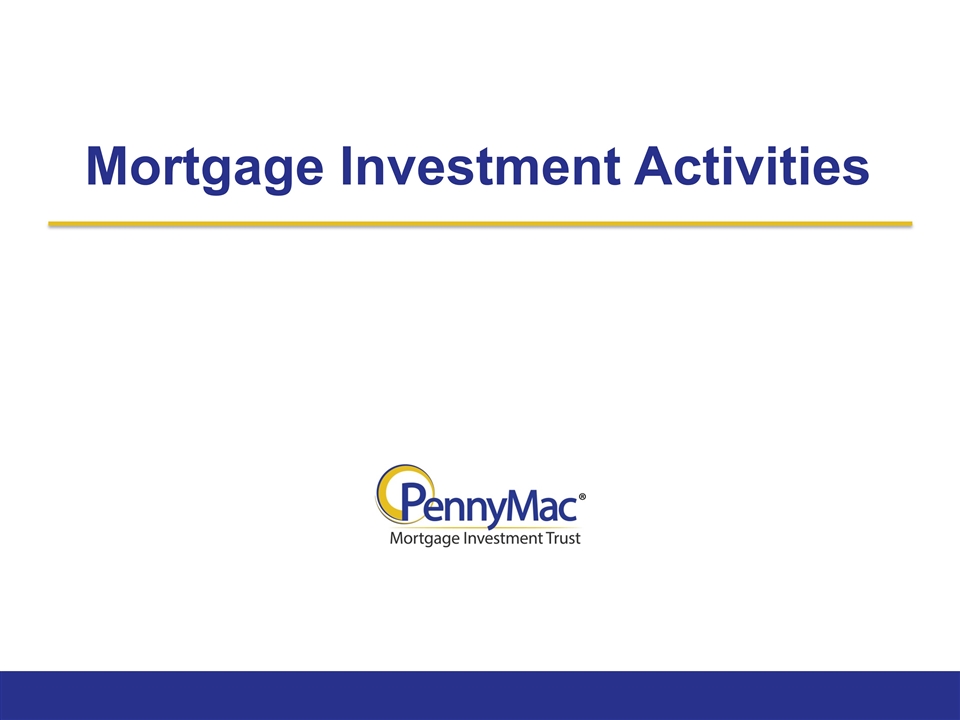
Mortgage Investment Activities
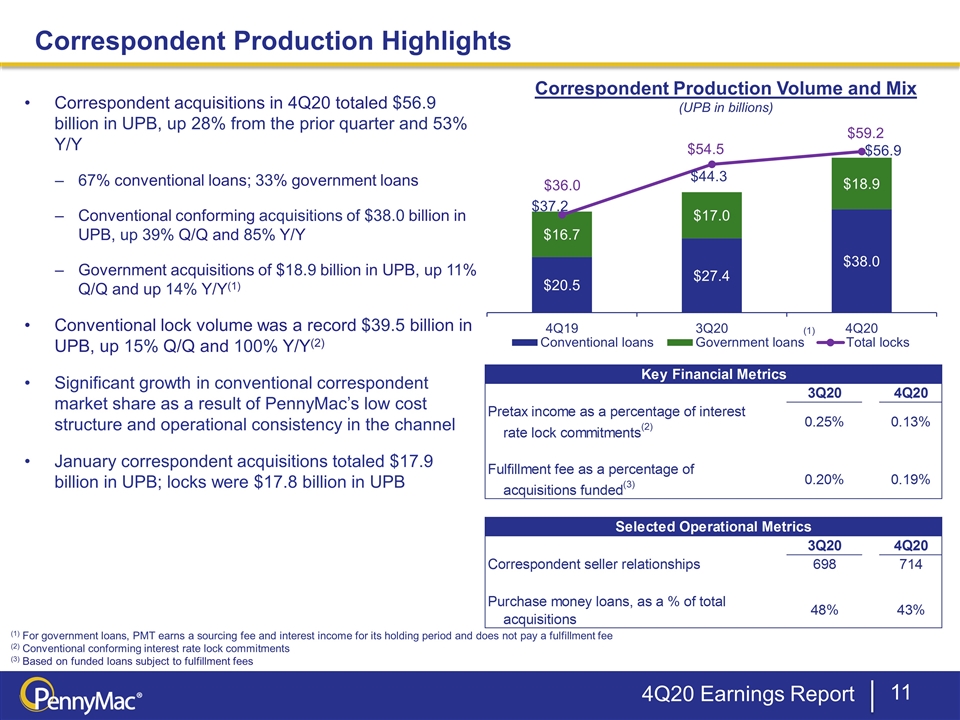
4Q20 Earnings Report Correspondent Production Highlights Correspondent Production Volume and Mix (UPB in billions) (1) For government loans, PMT earns a sourcing fee and interest income for its holding period and does not pay a fulfillment fee (2) Conventional conforming interest rate lock commitments (3) Based on funded loans subject to fulfillment fees (1) Correspondent acquisitions in 4Q20 totaled $56.9 billion in UPB, up 28% from the prior quarter and 53% Y/Y 67% conventional loans; 33% government loans Conventional conforming acquisitions of $38.0 billion in UPB, up 39% Q/Q and 85% Y/Y Government acquisitions of $18.9 billion in UPB, up 11% Q/Q and up 14% Y/Y(1) Conventional lock volume was a record $39.5 billion in UPB, up 15% Q/Q and 100% Y/Y(2) Significant growth in conventional correspondent market share as a result of PennyMac’s low cost structure and operational consistency in the channel January correspondent acquisitions totaled $17.9 billion in UPB; locks were $17.8 billion in UPB
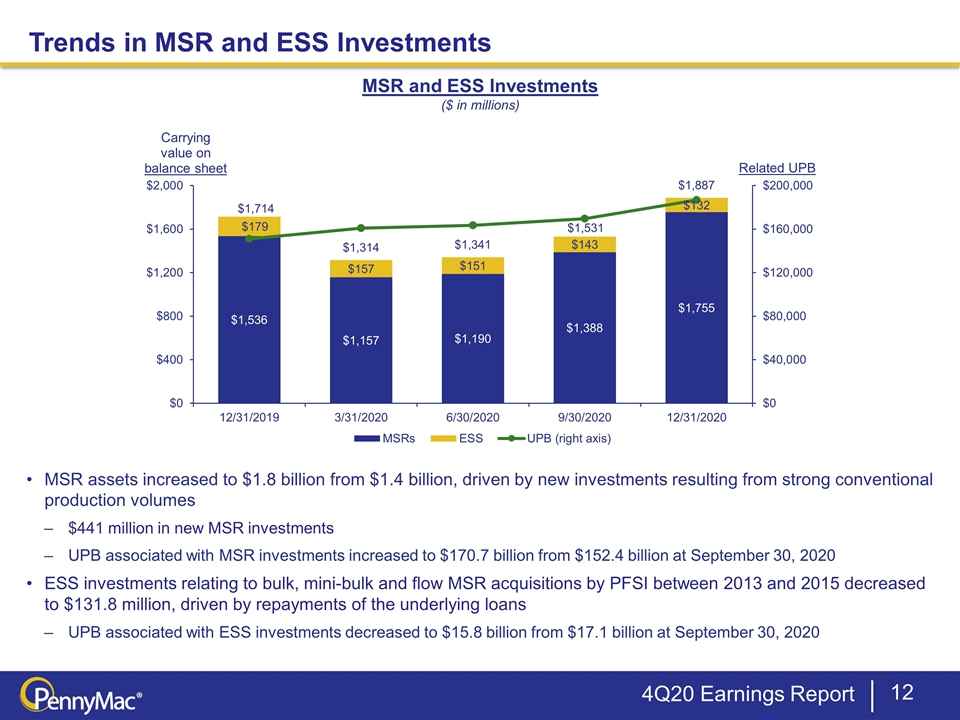
4Q20 Earnings Report Trends in MSR and ESS Investments MSR assets increased to $1.8 billion from $1.4 billion, driven by new investments resulting from strong conventional production volumes $441 million in new MSR investments UPB associated with MSR investments increased to $170.7 billion from $152.4 billion at September 30, 2020 ESS investments relating to bulk, mini-bulk and flow MSR acquisitions by PFSI between 2013 and 2015 decreased to $131.8 million, driven by repayments of the underlying loans UPB associated with ESS investments decreased to $15.8 billion from $17.1 billion at September 30, 2020 MSR and ESS Investments ($ in millions)
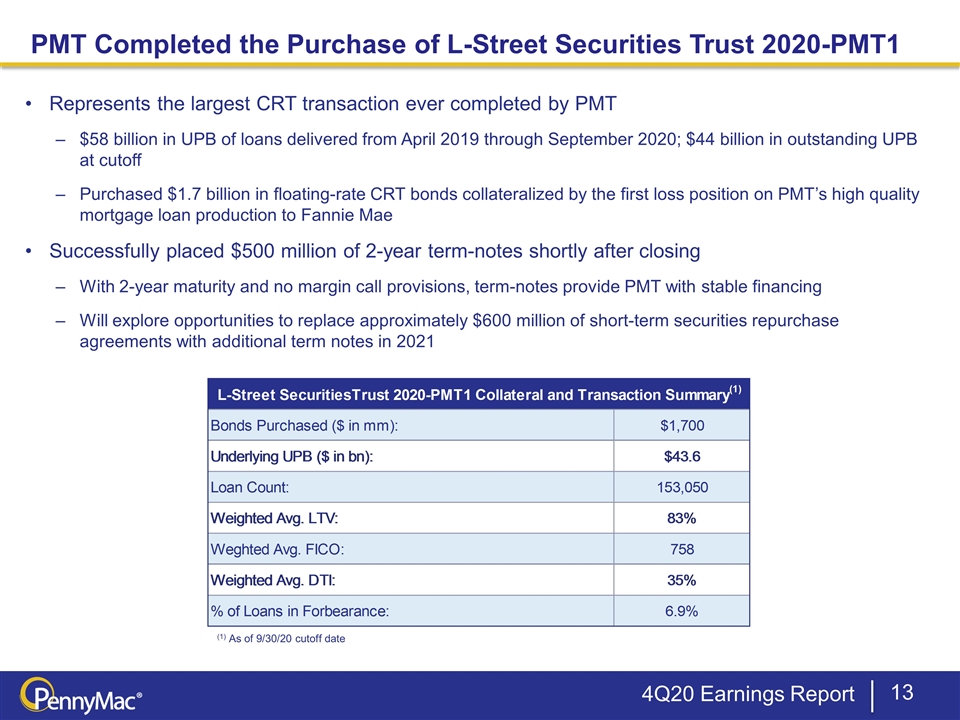
4Q20 Earnings Report PMT Completed the Purchase of L-Street Securities Trust 2020-PMT1 Represents the largest CRT transaction ever completed by PMT $58 billion in UPB of loans delivered from April 2019 through September 2020; $44 billion in outstanding UPB at cutoff Purchased $1.7 billion in floating-rate CRT bonds collateralized by the first loss position on PMT’s high quality mortgage loan production to Fannie Mae Successfully placed $500 million of 2-year term-notes shortly after closing With 2-year maturity and no margin call provisions, term-notes provide PMT with stable financing Will explore opportunities to replace approximately $600 million of short-term securities repurchase agreements with additional term notes in 2021 (1) As of 9/30/20 cutoff date
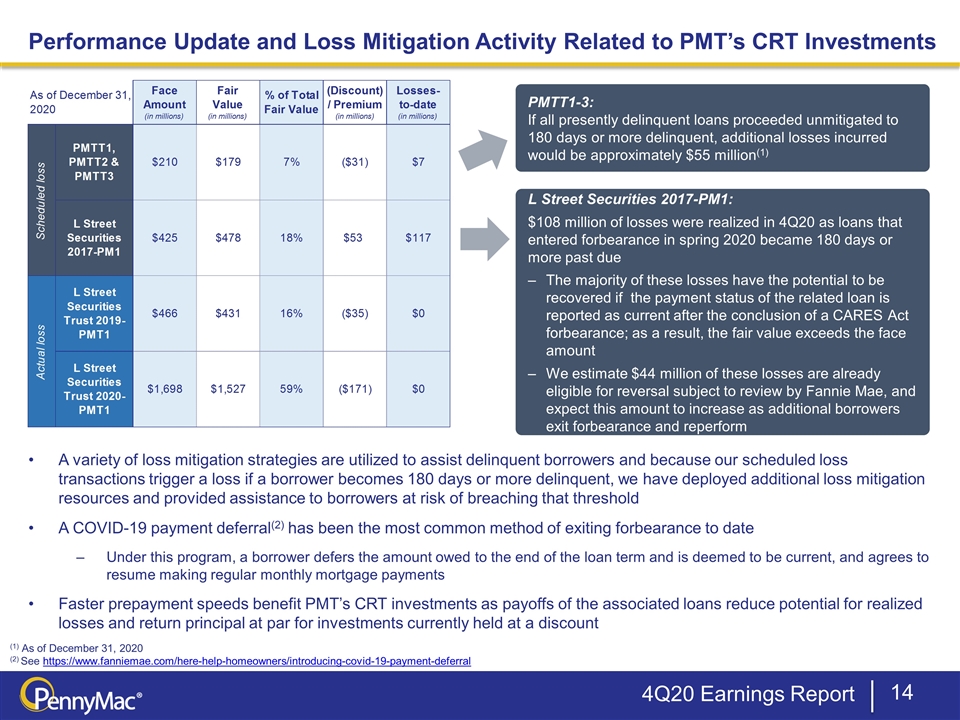
Performance Update and Loss Mitigation Activity Related to PMT’s CRT Investments 4Q20 Earnings Report (1) As of December 31, 2020 (2) See https://www.fanniemae.com/here-help-homeowners/introducing-covid-19-payment-deferral A variety of loss mitigation strategies are utilized to assist delinquent borrowers and because our scheduled loss transactions trigger a loss if a borrower becomes 180 days or more delinquent, we have deployed additional loss mitigation resources and provided assistance to borrowers at risk of breaching that threshold A COVID-19 payment deferral(2) has been the most common method of exiting forbearance to date Under this program, a borrower defers the amount owed to the end of the loan term and is deemed to be current, and agrees to resume making regular monthly mortgage payments Faster prepayment speeds benefit PMT’s CRT investments as payoffs of the associated loans reduce potential for realized losses and return principal at par for investments currently held at a discount PMTT1-3: If all presently delinquent loans proceeded unmitigated to 180 days or more delinquent, additional losses incurred would be approximately $55 million(1) L Street Securities 2017-PM1: $108 million of losses were realized in 4Q20 as loans that entered forbearance in spring 2020 became 180 days or more past due The majority of these losses have the potential to be recovered if the payment status of the related loan is reported as current after the conclusion of a CARES Act forbearance; as a result, the fair value exceeds the face amount We estimate $44 million of these losses are already eligible for reversal subject to review by Fannie Mae, and expect this amount to increase as additional borrowers exit forbearance and reperform
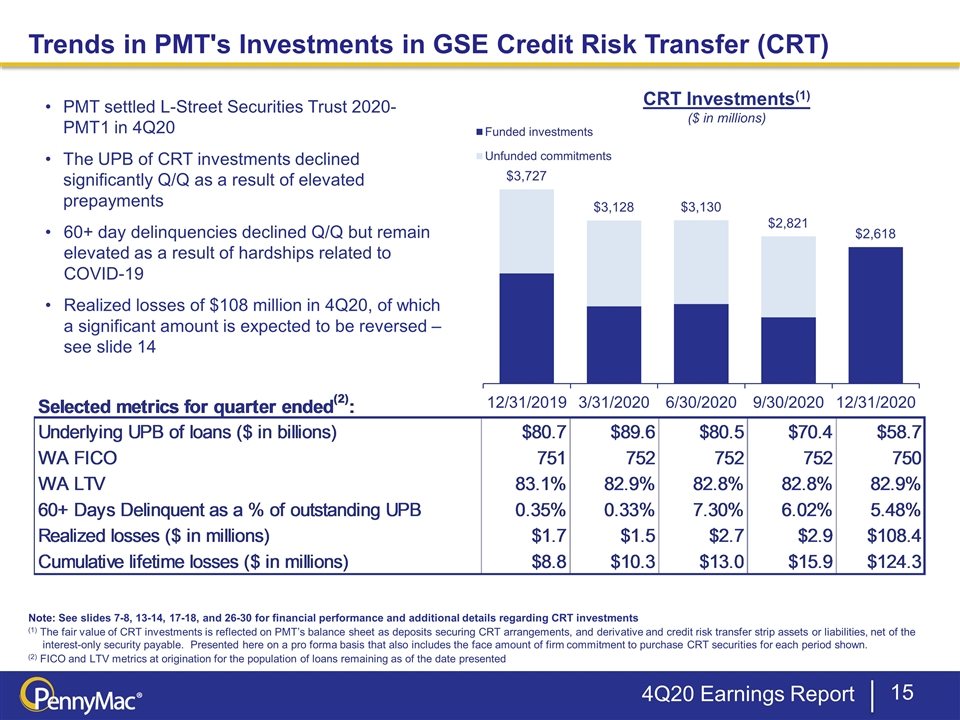
4Q20 Earnings Report Trends in PMT's Investments in GSE Credit Risk Transfer (CRT) PMT settled L-Street Securities Trust 2020-PMT1 in 4Q20 The UPB of CRT investments declined significantly Q/Q as a result of elevated prepayments 60+ day delinquencies declined Q/Q but remain elevated as a result of hardships related to COVID-19 Realized losses of $108 million in 4Q20, of which a significant amount is expected to be reversed – see slide 14 Note: See slides 7-8, 13-14, 17-18, and 26-30 for financial performance and additional details regarding CRT investments (1) The fair value of CRT investments is reflected on PMT’s balance sheet as deposits securing CRT arrangements, and derivative and credit risk transfer strip assets or liabilities, net of the interest-only security payable. Presented here on a pro forma basis that also includes the face amount of firm commitment to purchase CRT securities for each period shown. (2) FICO and LTV metrics at origination for the population of loans remaining as of the date presented CRT Investments(1) ($ in millions)
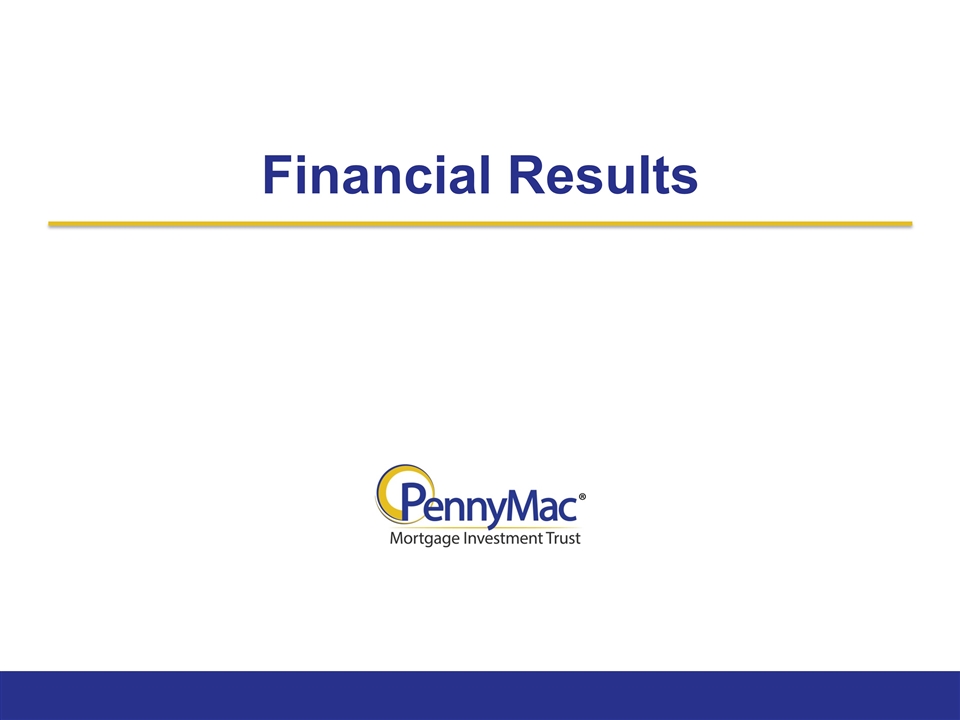
Financial Results
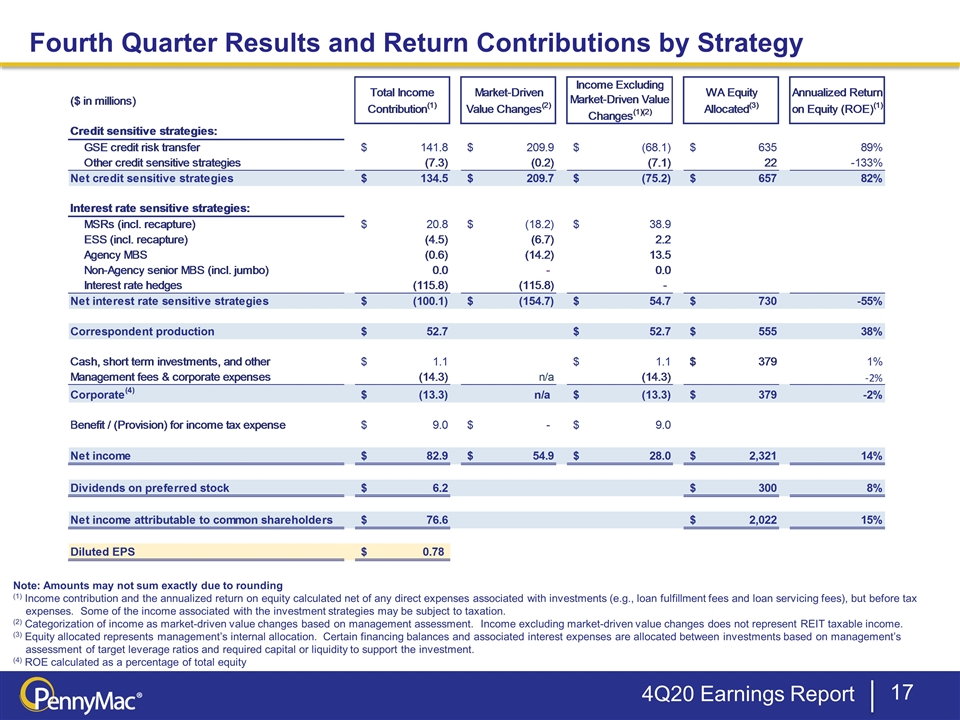
4Q20 Earnings Report Note: Amounts may not sum exactly due to rounding (1) Income contribution and the annualized return on equity calculated net of any direct expenses associated with investments (e.g., loan fulfillment fees and loan servicing fees), but before tax expenses. Some of the income associated with the investment strategies may be subject to taxation. (2) Categorization of income as market-driven value changes based on management assessment. Income excluding market-driven value changes does not represent REIT taxable income. (3) Equity allocated represents management’s internal allocation. Certain financing balances and associated interest expenses are allocated between investments based on management’s assessment of target leverage ratios and required capital or liquidity to support the investment. (4) ROE calculated as a percentage of total equity Fourth Quarter Results and Return Contributions by Strategy
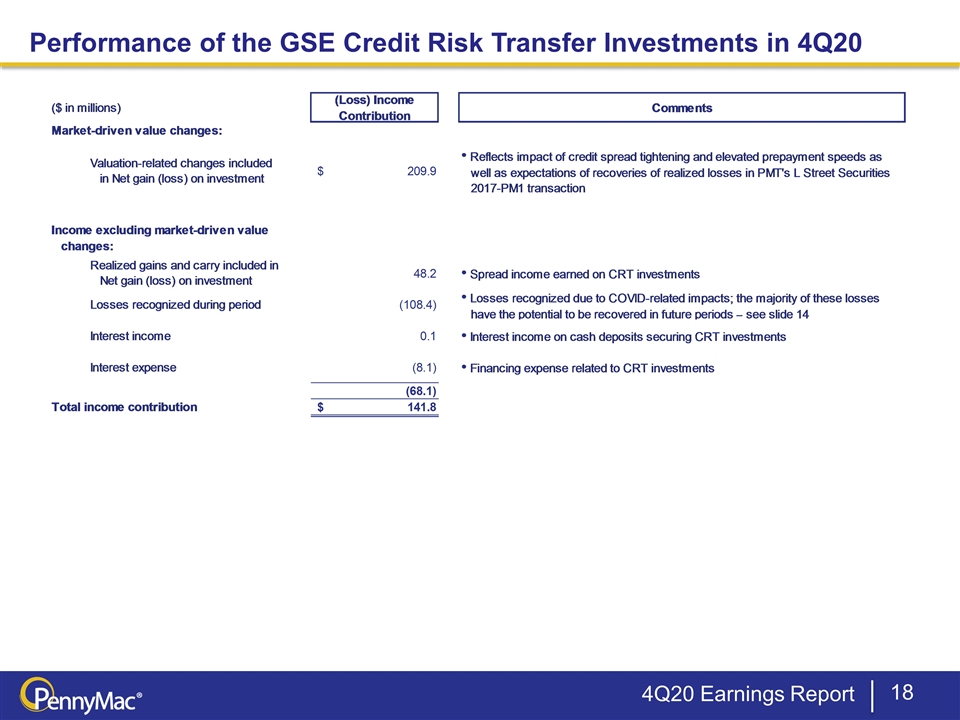
4Q20 Earnings Report Performance of the GSE Credit Risk Transfer Investments in 4Q20
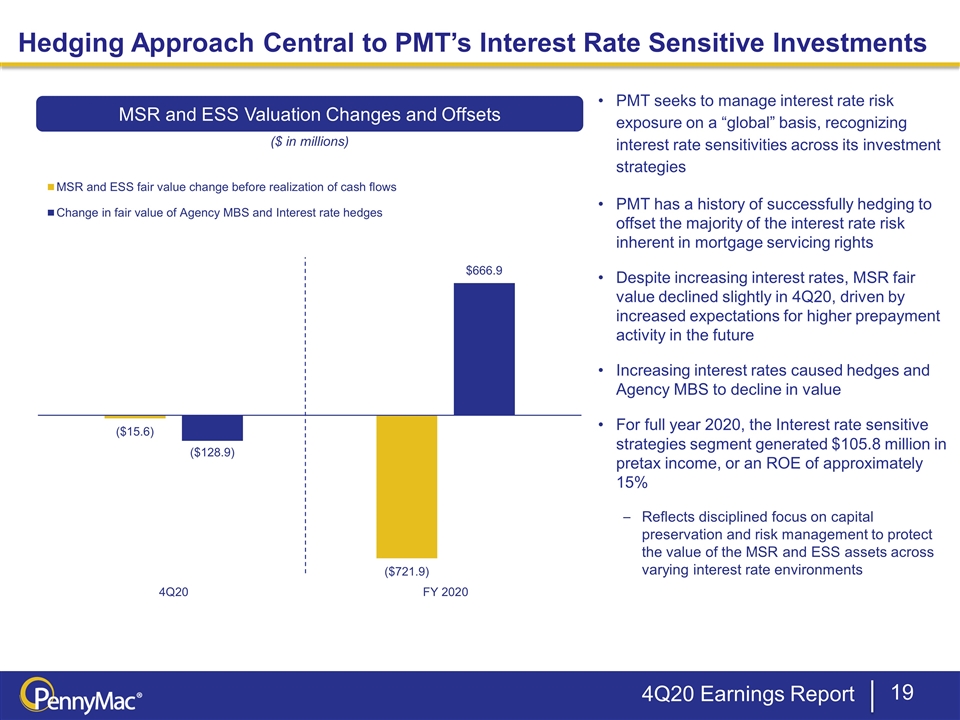
4Q20 Earnings Report Hedging Approach Central to PMT’s Interest Rate Sensitive Investments PMT seeks to manage interest rate risk exposure on a “global” basis, recognizing interest rate sensitivities across its investment strategies PMT has a history of successfully hedging to offset the majority of the interest rate risk inherent in mortgage servicing rights Despite increasing interest rates, MSR fair value declined slightly in 4Q20, driven by increased expectations for higher prepayment activity in the future Increasing interest rates caused hedges and Agency MBS to decline in value For full year 2020, the Interest rate sensitive strategies segment generated $105.8 million in pretax income, or an ROE of approximately 15% Reflects disciplined focus on capital preservation and risk management to protect the value of the MSR and ESS assets across varying interest rate environments MSR and ESS Valuation Changes and Offsets ($ in millions)
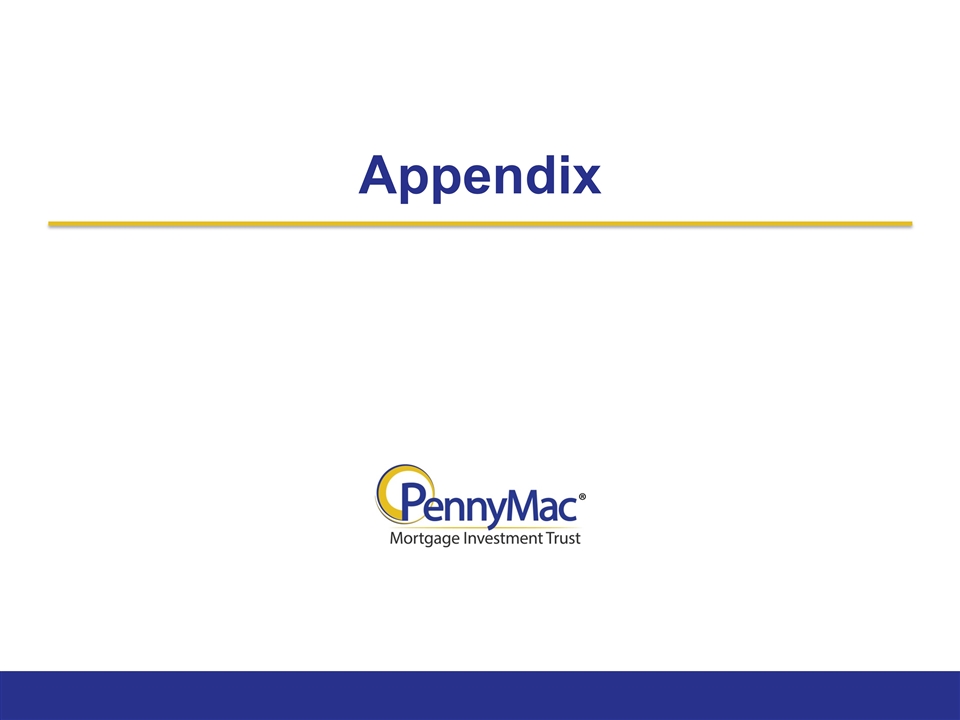
Appendix
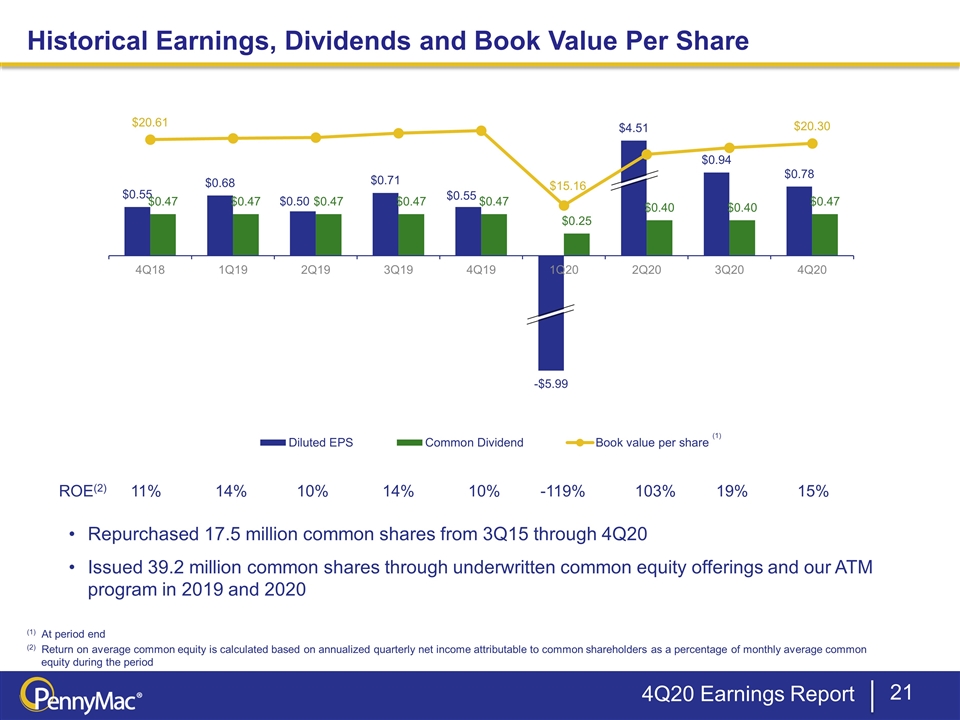
4Q20 Earnings Report Historical Earnings, Dividends and Book Value Per Share (1) At period end (2) Return on average common equity is calculated based on annualized quarterly net income attributable to common shareholders as a percentage of monthly average common equity during the period Repurchased 17.5 million common shares from 3Q15 through 4Q20 Issued 39.2 million common shares through underwritten common equity offerings and our ATM program in 2019 and 2020 ROE(2) 11% 14% 10% 14% 10% -119% 103% 19% 15% (1)
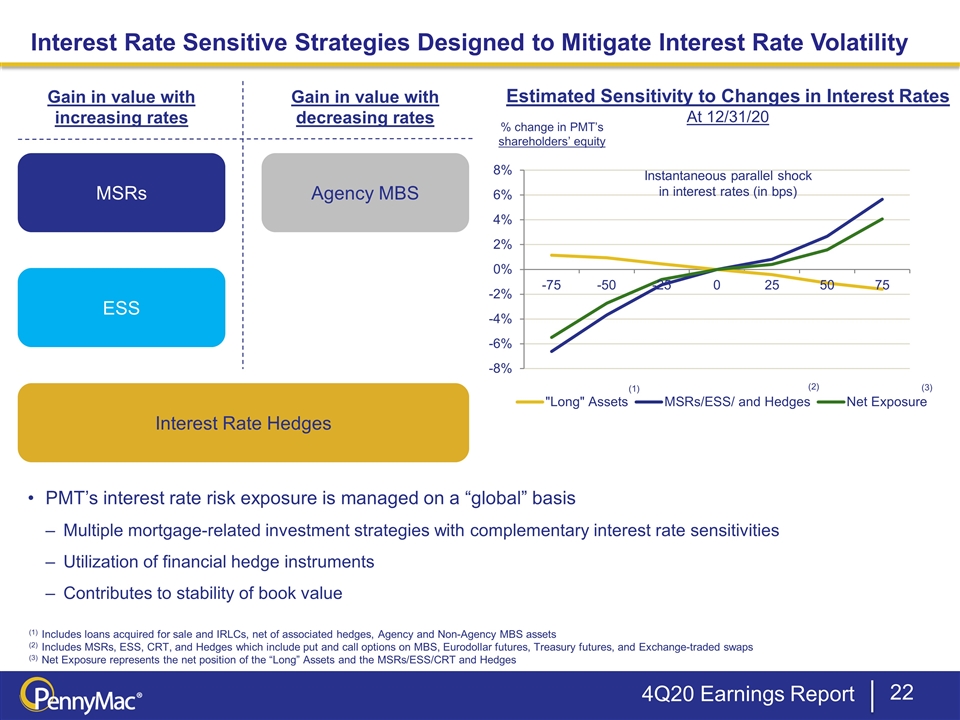
4Q20 Earnings Report Interest Rate Sensitive Strategies Designed to Mitigate Interest Rate Volatility Estimated Sensitivity to Changes in Interest Rates At 12/31/20 Instantaneous parallel shock in interest rates (in bps) % change in PMT’s shareholders’ equity (1) (2) (3) Gain in value with increasing rates Gain in value with decreasing rates MSRs ESS Agency MBS Interest Rate Hedges PMT’s interest rate risk exposure is managed on a “global” basis Multiple mortgage-related investment strategies with complementary interest rate sensitivities Utilization of financial hedge instruments Contributes to stability of book value (1) Includes loans acquired for sale and IRLCs, net of associated hedges, Agency and Non-Agency MBS assets (2) Includes MSRs, ESS, CRT, and Hedges which include put and call options on MBS, Eurodollar futures, Treasury futures, and Exchange-traded swaps (3) Net Exposure represents the net position of the “Long” Assets and the MSRs/ESS/CRT and Hedges
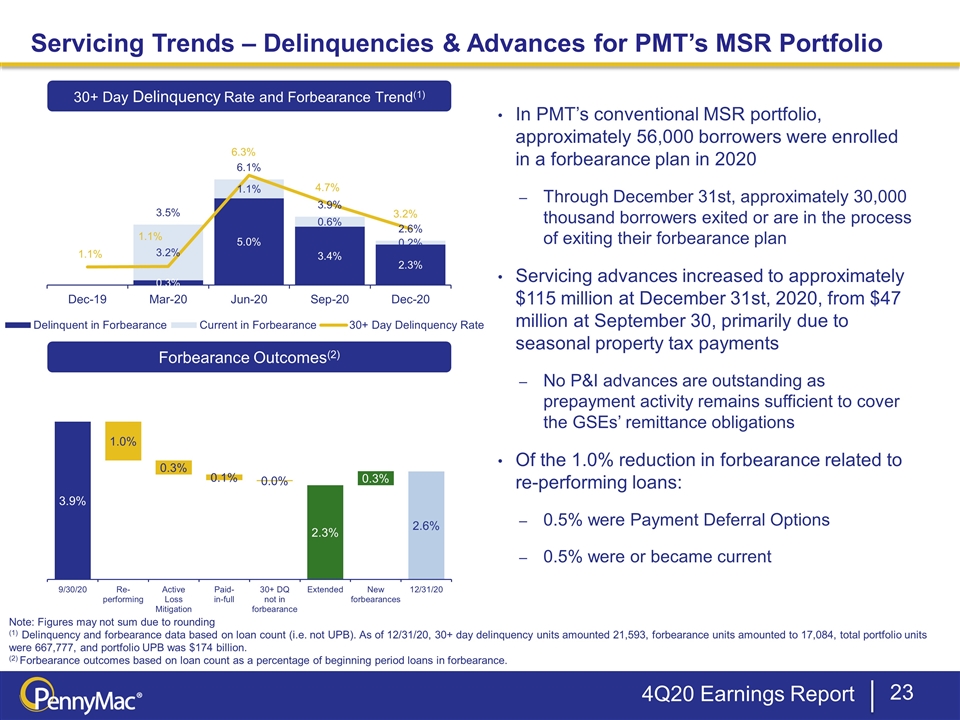
Servicing Trends – Delinquencies & Advances for PMT’s MSR Portfolio 4Q20 Earnings Report In PMT’s conventional MSR portfolio, approximately 56,000 borrowers were enrolled in a forbearance plan in 2020 Through December 31st, approximately 30,000 thousand borrowers exited or are in the process of exiting their forbearance plan Servicing advances increased to approximately $115 million at December 31st, 2020, from $47 million at September 30, primarily due to seasonal property tax payments No P&I advances are outstanding as prepayment activity remains sufficient to cover the GSEs’ remittance obligations Of the 1.0% reduction in forbearance related to re-performing loans: 0.5% were Payment Deferral Options 0.5% were or became current 30+ Day Delinquency Rate and Forbearance Trend(1) Forbearance Outcomes(2) Note: Figures may not sum due to rounding (1) Delinquency and forbearance data based on loan count (i.e. not UPB). As of 12/31/20, 30+ day delinquency units amounted 21,593, forbearance units amounted to 17,084, total portfolio units were 667,777, and portfolio UPB was $174 billion. (2) Forbearance outcomes based on loan count as a percentage of beginning period loans in forbearance.
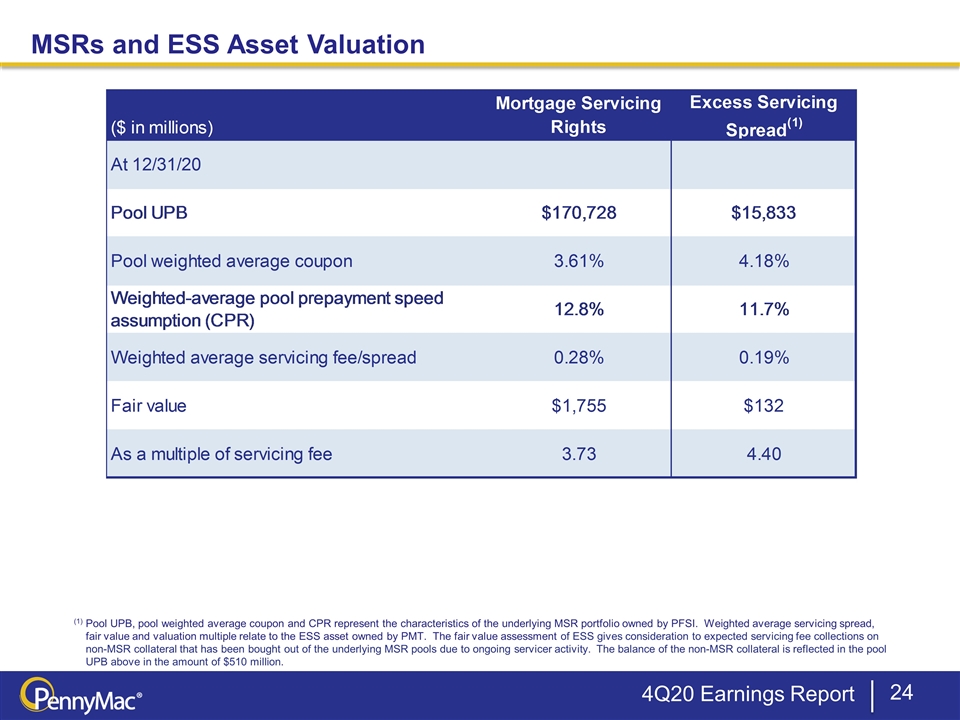
MSRs and ESS Asset Valuation Unaudited (1) Pool UPB, pool weighted average coupon and CPR represent the characteristics of the underlying MSR portfolio owned by PFSI. Weighted average servicing spread, fair value and valuation multiple relate to the ESS asset owned by PMT. The fair value assessment of ESS gives consideration to expected servicing fee collections on non-MSR collateral that has been bought out of the underlying MSR pools due to ongoing servicer activity. The balance of the non-MSR collateral is reflected in the pool UPB above in the amount of $510 million. 4Q20 Earnings Report
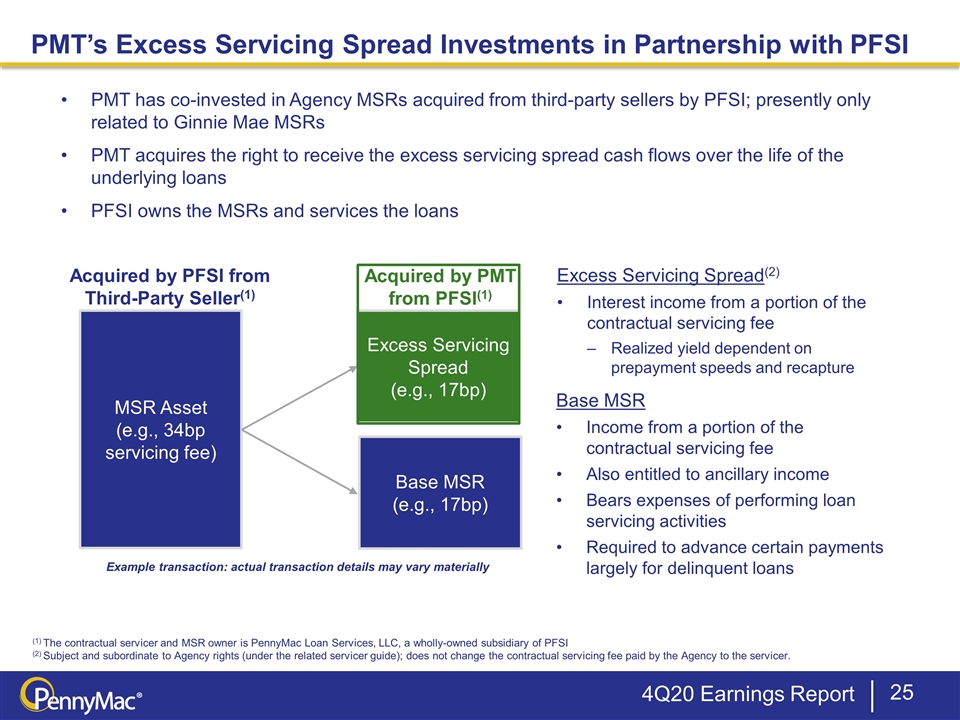
(1) The contractual servicer and MSR owner is PennyMac Loan Services, LLC, a wholly-owned subsidiary of PFSI (2) Subject and subordinate to Agency rights (under the related servicer guide); does not change the contractual servicing fee paid by the Agency to the servicer. Excess Servicing Spread (e.g., 17bp) MSR Asset (e.g., 34bp servicing fee) Acquired by PFSI from Third-Party Seller(1) PMT has co-invested in Agency MSRs acquired from third-party sellers by PFSI; presently only related to Ginnie Mae MSRs PMT acquires the right to receive the excess servicing spread cash flows over the life of the underlying loans PFSI owns the MSRs and services the loans Excess Servicing Spread(2) Interest income from a portion of the contractual servicing fee Realized yield dependent on prepayment speeds and recapture Base MSR Income from a portion of the contractual servicing fee Also entitled to ancillary income Bears expenses of performing loan servicing activities Required to advance certain payments largely for delinquent loans Base MSR (e.g., 17bp) Acquired by PMT from PFSI(1) Example transaction: actual transaction details may vary materially PMT’s Excess Servicing Spread Investments in Partnership with PFSI 4Q20 Earnings Report
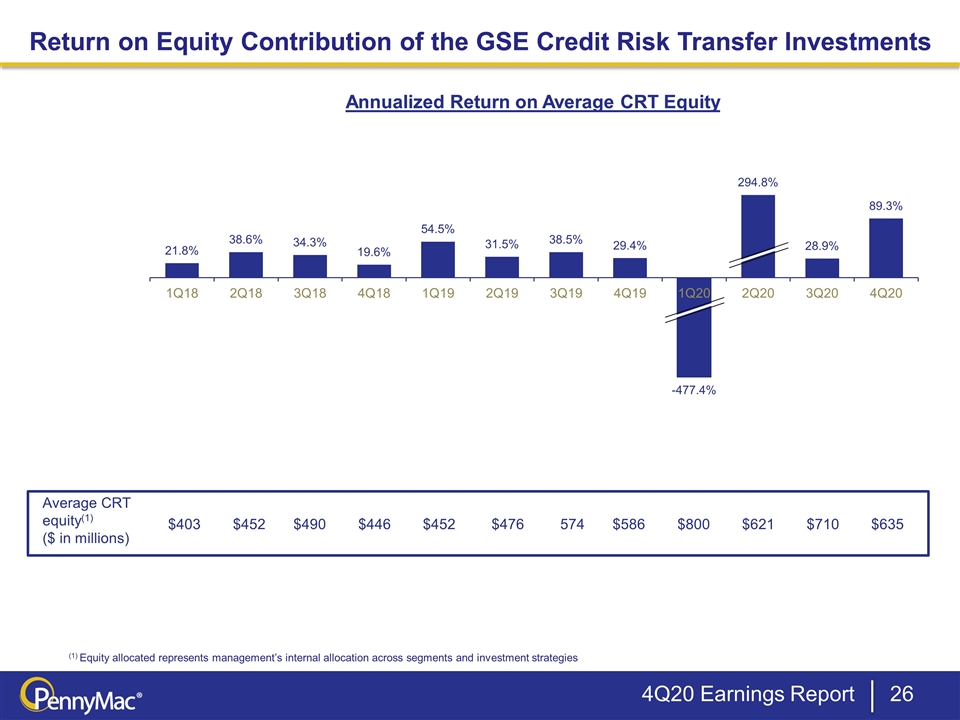
Return on Equity Contribution of the GSE Credit Risk Transfer Investments 4Q20 Earnings Report Return on Equity Contribution of the GSE Credit Risk Transfer Investments Annualized Return on Average CRT Equity (1) Equity allocated represents management’s internal allocation across segments and investment strategies Annualized Return on Average CRT Equity Average CRT equity(1) ($ in millions) $403 $452 $490 $446 $452 $476 574 $586 $800 $621 $710 $635
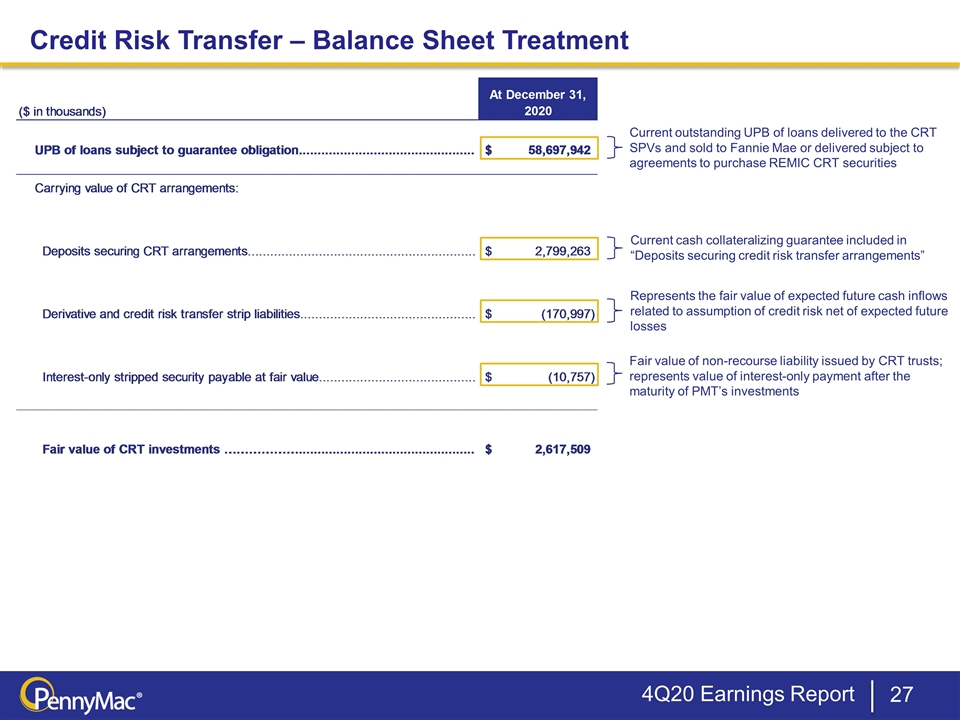
Credit Risk Transfer – Balance Sheet Treatment 4Q20 Earnings Report Current outstanding UPB of loans delivered to the CRT SPVs and sold to Fannie Mae or delivered subject to agreements to purchase REMIC CRT securities Current cash collateralizing guarantee included in “Deposits securing credit risk transfer arrangements” Represents the fair value of expected future cash inflows related to assumption of credit risk net of expected future losses Fair value of non-recourse liability issued by CRT trusts; represents value of interest-only payment after the maturity of PMT’s investments
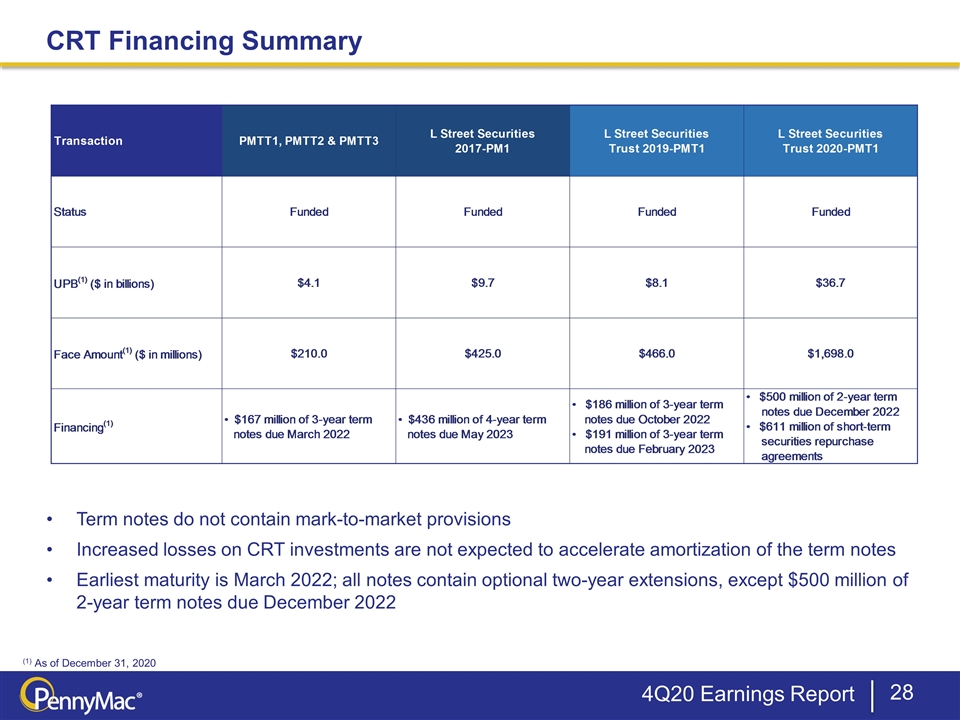
4Q20 Earnings Report CRT Financing Summary (1) As of December 31, 2020 Term notes do not contain mark-to-market provisions Increased losses on CRT investments are not expected to accelerate amortization of the term notes Earliest maturity is March 2022; all notes contain optional two-year extensions, except $500 million of 2-year term notes due December 2022
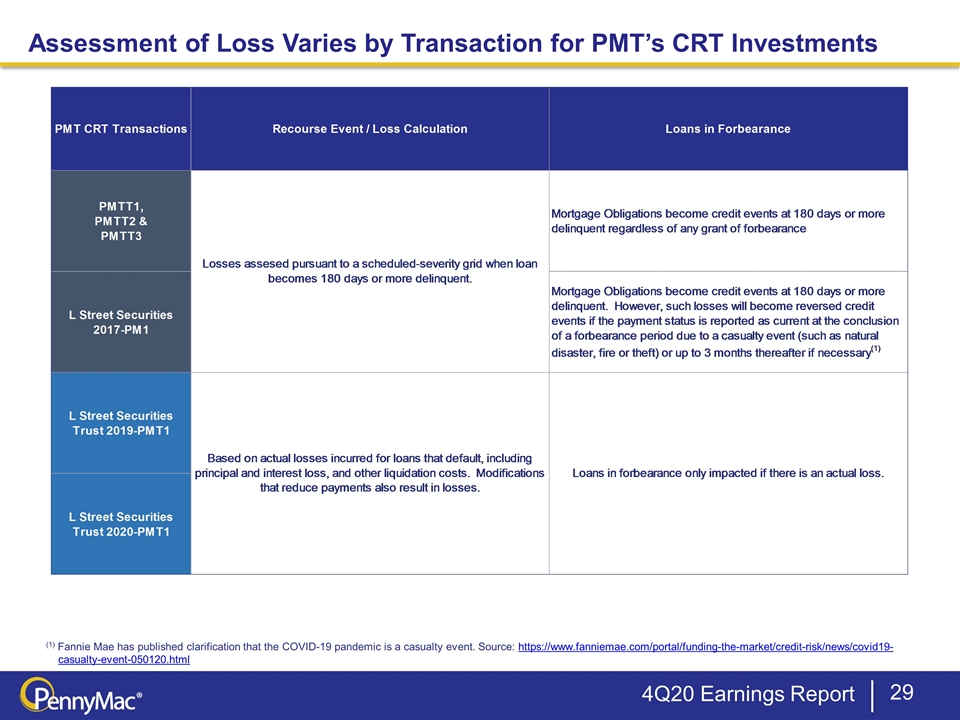
Assessment of Loss Varies by Transaction for PMT’s CRT Investments 4Q20 Earnings Report (1) Fannie Mae has published clarification that the COVID-19 pandemic is a casualty event. Source: https://www.fanniemae.com/portal/funding-the-market/credit-risk/news/covid19-casualty-event-050120.html
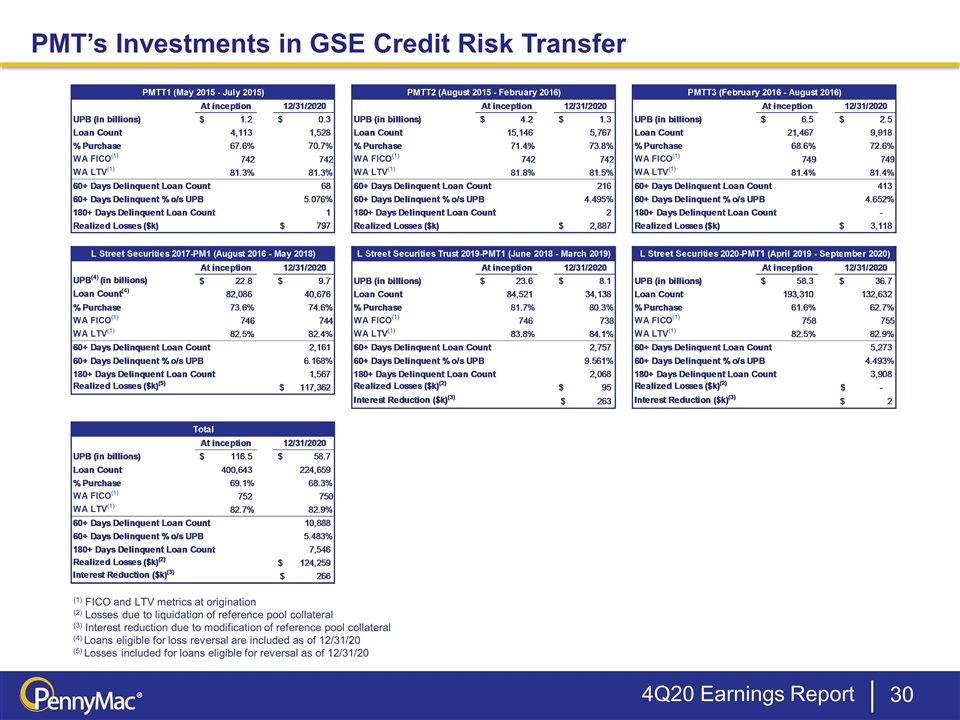
PMT’s Investments in GSE Credit Risk Transfer 4Q20 Earnings Report (1) FICO and LTV metrics at origination (2) Losses due to liquidation of reference pool collateral (3) Interest reduction due to modification of reference pool collateral (4) Loans eligible for loss reversal are included as of 12/31/20 (5) Losses included for loans eligible for reversal as of 12/31/20
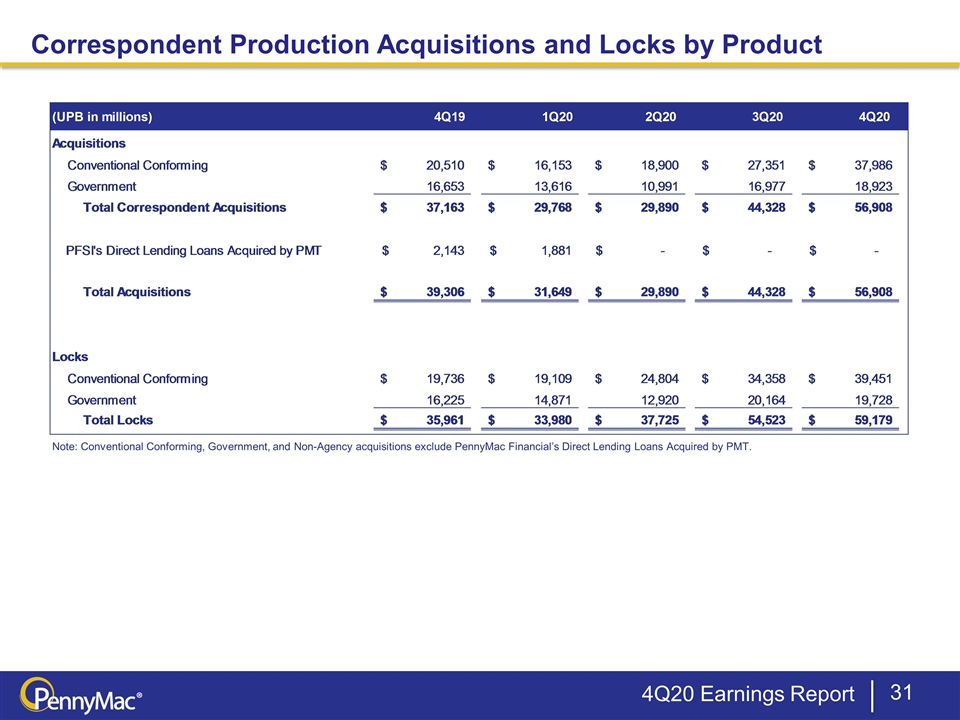
4Q20 Earnings Report Correspondent Production Acquisitions and Locks by Product Note: Conventional Conforming, Government, and Non-Agency acquisitions exclude PennyMac Financial’s Direct Lending Loans Acquired by PMT.






























